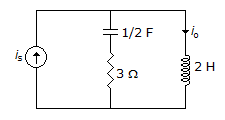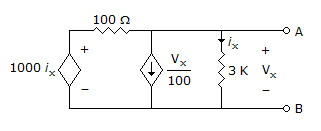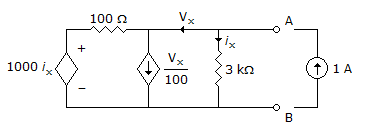Electronics and Communication Engineering - Exam Questions Papers
Exercise : Exam Questions Papers - Exam Paper 3
- Exam Questions Papers - Exam Paper 12
- Exam Questions Papers - Exam Paper 22
- Exam Questions Papers - Exam Paper 21
- Exam Questions Papers - Exam Paper 20
- Exam Questions Papers - Exam Paper 19
- Exam Questions Papers - Exam Paper 18
- Exam Questions Papers - Exam Paper 17
- Exam Questions Papers - Exam Paper 16
- Exam Questions Papers - Exam Paper 15
- Exam Questions Papers - Exam Paper 14
- Exam Questions Papers - Exam Paper 13
- Exam Questions Papers - Exam Paper 1
- Exam Questions Papers - Exam Paper 11
- Exam Questions Papers - Exam Paper 10
- Exam Questions Papers - Exam Paper 9
- Exam Questions Papers - Exam Paper 8
- Exam Questions Papers - Exam Paper 7
- Exam Questions Papers - Exam Paper 6
- Exam Questions Papers - Exam Paper 5
- Exam Questions Papers - Exam Paper 4
- Exam Questions Papers - Exam Paper 3
- Exam Questions Papers - Exam Paper 2
11.
The circuit is shown in figure.

The current transfer ratio , is
, is

The current transfer ratio
 , is
, isAnswer: Option
Explanation:
 .
.
12.
Let f(A, B) = A ⊕ B; then the simplified form of the function f(f(x ⊕ y, z)w) is
Answer: Option
Explanation:
f(A, B) = A ⊕ B
f(x ⊕ y, z) = (x ⊕ y ⊕ z) = M
But f(MW) is undefined.
13.
A system has 12 poles or 2 zeros. Its high frequency asymptote in its magnitude plot has slope of
Answer: Option
Explanation:
High frequency asymptotes = - 20(12) + 2(20) = - 200 dB/DECADE.
14.
(1 2 1)x = (1 0 0)4 Then x is equal to
Answer: Option
Explanation:
x2 = 2x + 1 = 16
x2 + 2x - 15 = 0, (x - 3)(x + 5) = 0, x = 3, - 5
Thus x = 3.
15.
For the network shown below, the Thevenin voltage and RTH is equal to __________


Answer: Option
Explanation:
Since there is no independent source in the network; VTH = 0. To find RTH apply 1 A current source across A and B.

Apply KCL at node Vx

as 


Solving Vx = 58.82 V
∴  .
.
Quick links
Quantitative Aptitude
Verbal (English)
Reasoning
Programming
Interview
Placement Papers



